Abstract
The treatment of verapamil toxicity was examined in lightly sedated dogs. Verapamil, administered as a bolus (0.72 mg/kg) followed by a continuous infusion (0.11 mg/kg per min), decreased cardiac output (CO) from 3.1 +/- 0.1 to 1.7 +/- 0.1 liter/min (P less than 0.001), heart rate (HR) from 85 +/- 4 to 57 +/- 3 beats/min (P less than 0.001), left ventricular derivative of pressure with respect to time (LV dP/dt) from 2,085 +/- 828 to 783 +/- 78 mm Hg/s (P less than 0.001), mean aortic pressure (AO) from 77 +/- 4 to 38 +/- 2 mm Hg (P less than 0.001) and stroke volume from 39 +/- 3 to 28 +/- 2 ml/beat (P less than 0.01). In verapamil-toxic animals isoproterenol increased HR, CO, LV dP/dt, and AO; calcium chloride increased LV dP/dt and AO; norepinephrine, epinephrine, and dopamine increased CO, AO, and LV dP/dt, atropine increased HR, CO, and AO. Phenylephrine (13-55 micrograms/kg per min) produced no changes except a small increase in AO while very high dose phenylephrine (300 micrograms/kg per min) increased AO, CO, and LV dP/dt. 4-Aminopyridine (4-AP) increased HR, CO, LV dP/dt, and AO. When administered prior to verapamil, 4-AP prevented the development of verapamil toxicity as shown by the significantly higher AO (P less than 0.001), CO (P less than 0.01), and LV dP/dt (P less than 0.01) when 4-AP followed by verapamil was compared to verapamil alone. In conclusion, there does not appear to be a single specific therapy for verapamil toxicity, however it can be partially corrected by presently available pharmacologic therapy and 4-AP.
Full text
PDF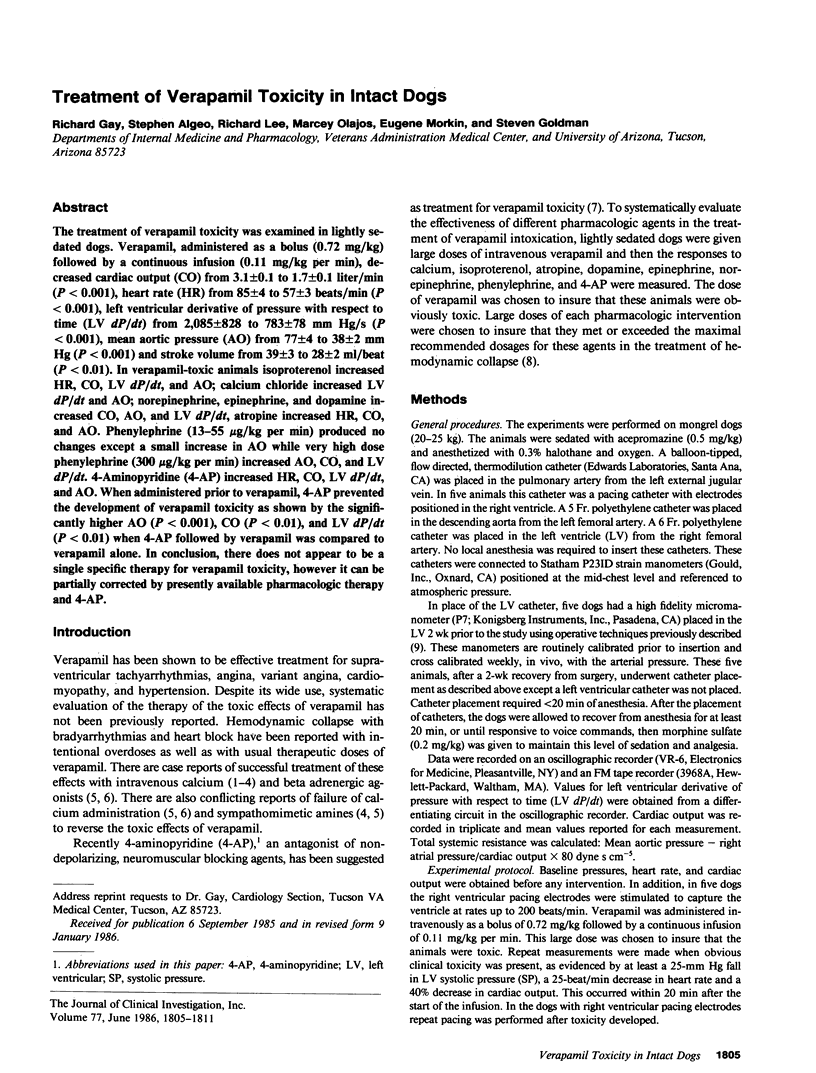
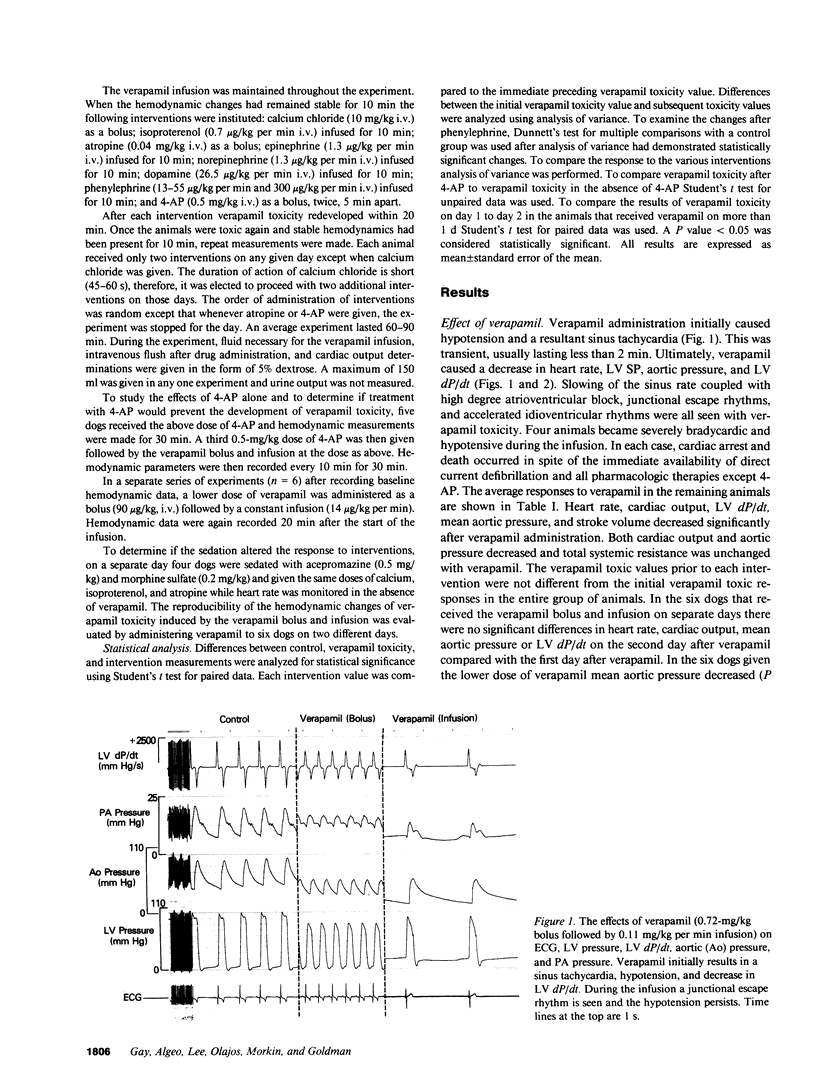
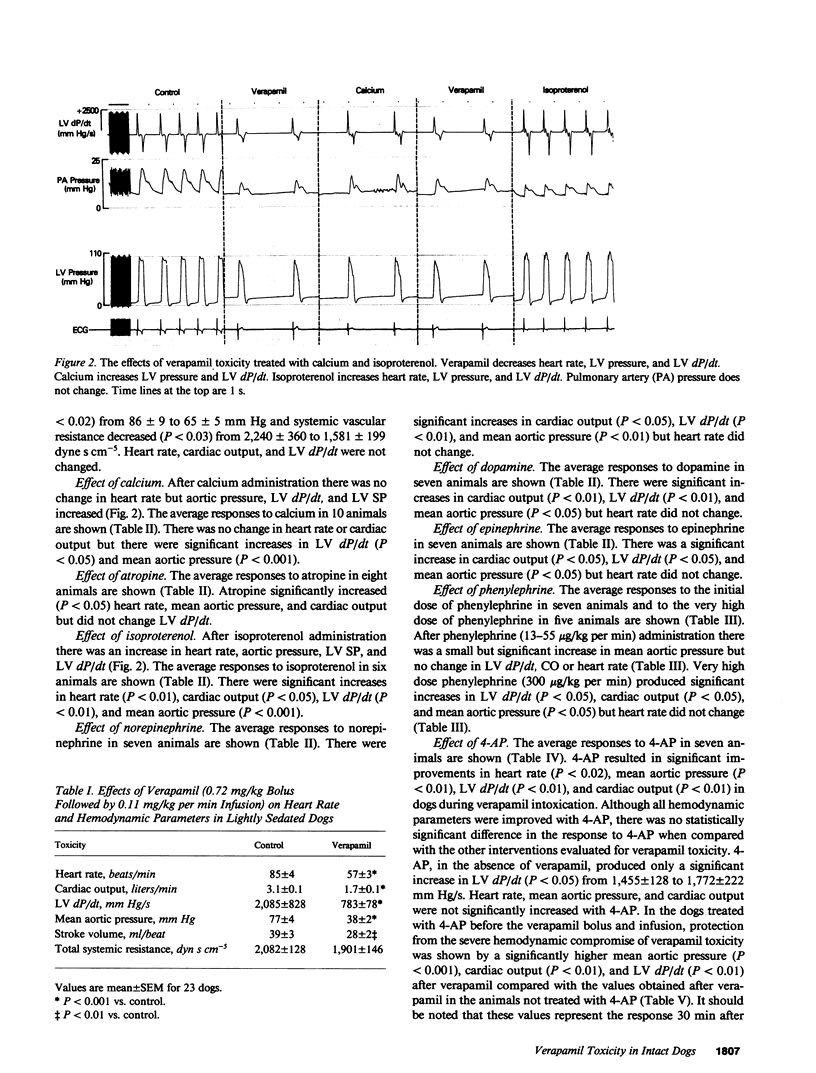
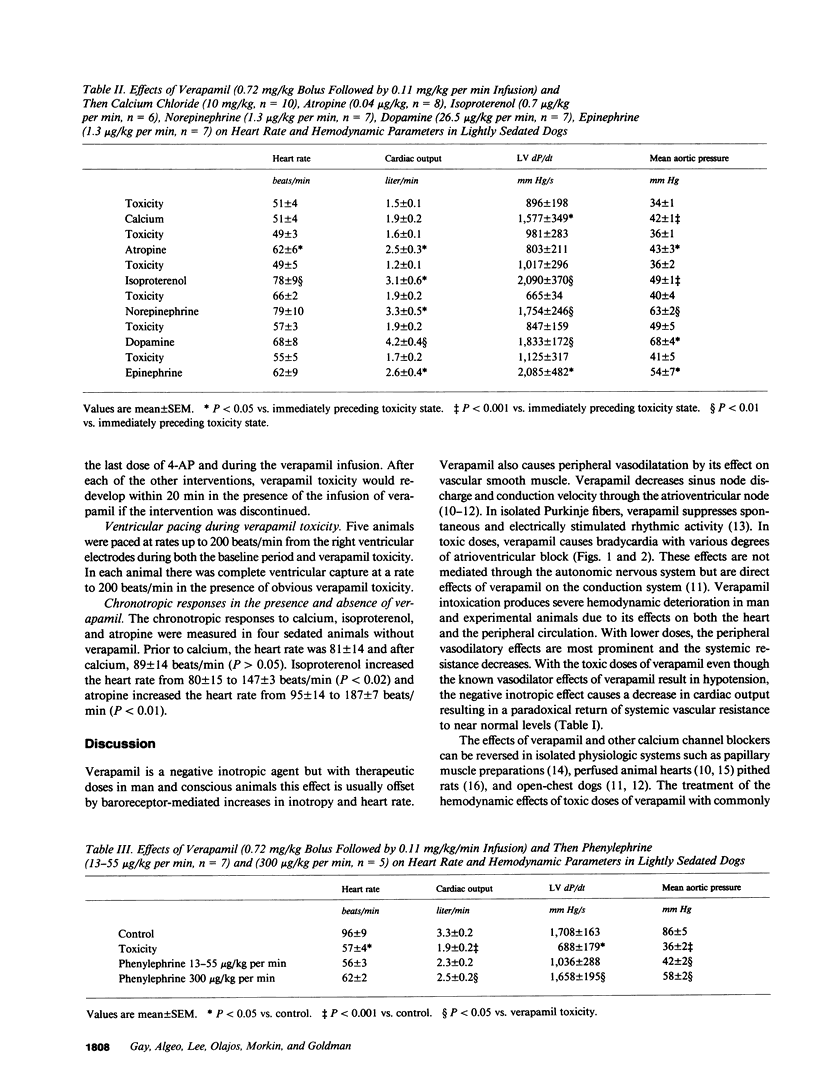
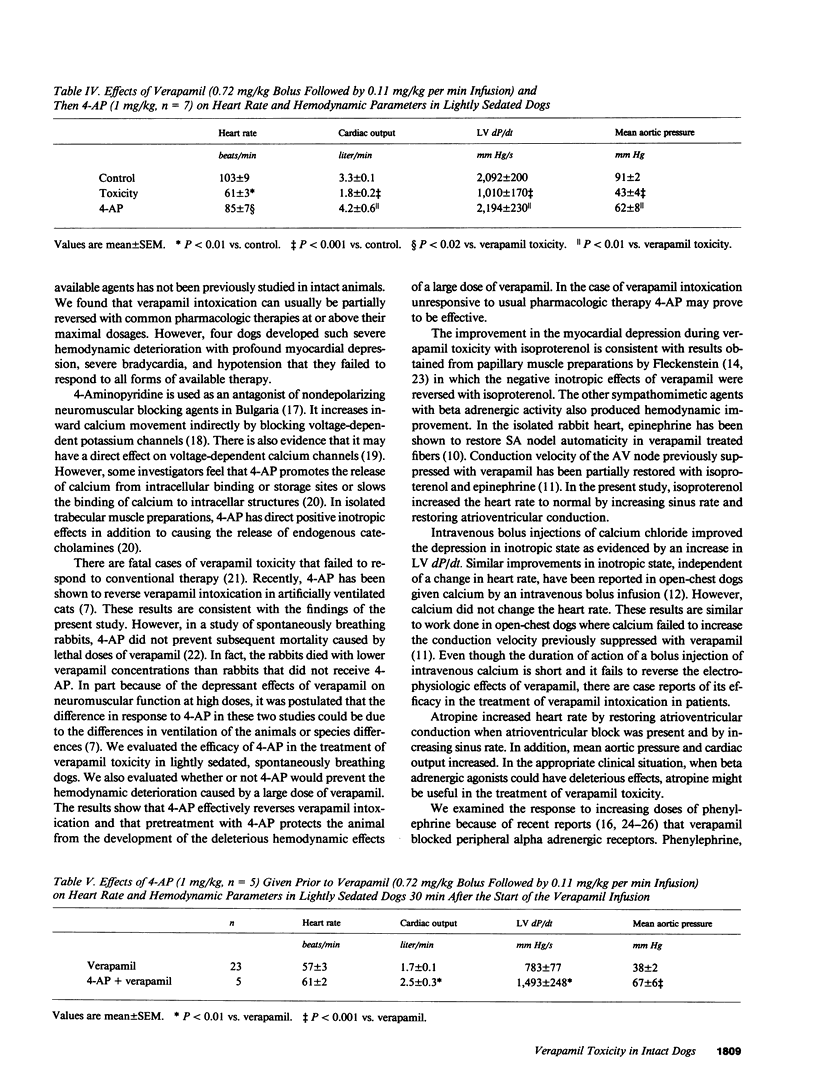
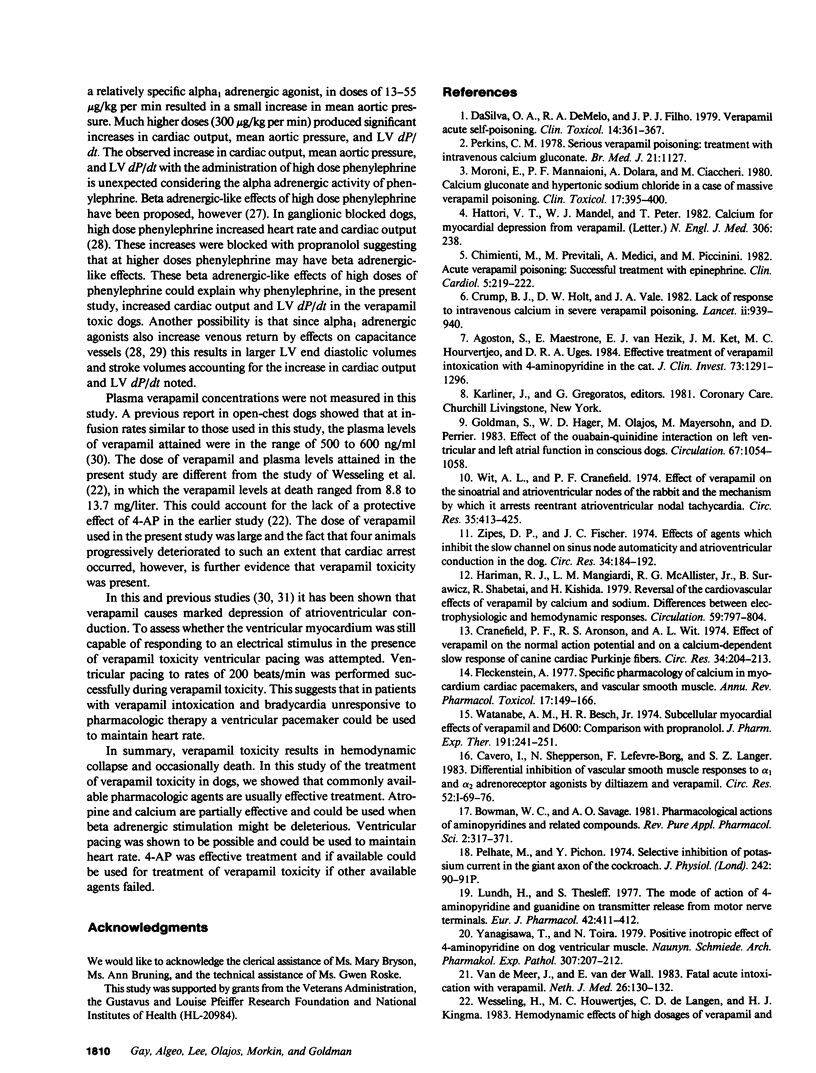
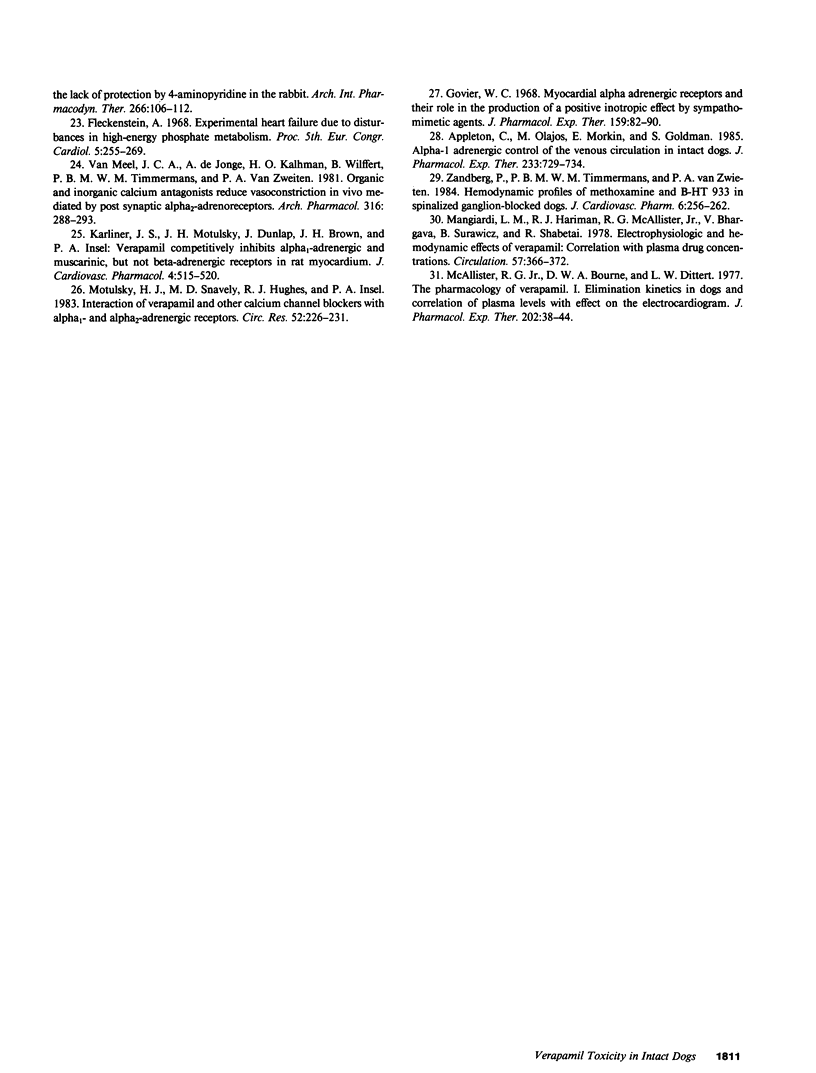
Selected References
These references are in PubMed. This may not be the complete list of references from this article.
- Agoston S., Maestrone E., van Hezik E. J., Ket J. M., Houwertjes M. C., Uges D. R. Effective treatment of verapamil intoxication with 4-aminopyridine in the cat. J Clin Invest. 1984 May;73(5):1291–1296. doi: 10.1172/JCI111331. [DOI] [PMC free article] [PubMed] [Google Scholar]
- Appleton C., Olajos M., Morkin E., Goldman S. Alpha-1 adrenergic control of the venous circulation in intact dogs. J Pharmacol Exp Ther. 1985 Jun;233(3):729–734. [PubMed] [Google Scholar]
- Bowman W. C., Savage A. O. Pharmacological actions of aminopyridines and related compounds. Rev Pure Appl Pharmacol Sci. 1981 Oct-Dec;2(4):317–371. [PubMed] [Google Scholar]
- Chimienti M., Previtali M., Medicia A., Piccinini M. Acute verapamil poisoning: successful treatment with epinephrine. Clin Cardiol. 1982 Mar;5(3):219–222. doi: 10.1002/clc.4960050304. [DOI] [PubMed] [Google Scholar]
- Cranefield P. F., Aronson R. S., Wit A. L. Effect of verapamil on the noraml action potential and on a calcium-dependent slow response of canine cardiac Purkinje fibers. Circ Res. 1974 Feb;34(2):204–213. doi: 10.1161/01.res.34.2.204. [DOI] [PubMed] [Google Scholar]
- Crump B. J., Holt D. W., Vale J. A. Lack of response to intravenous calcium in severe verapamil poisoning. Lancet. 1982 Oct 23;2(8304):939–940. doi: 10.1016/s0140-6736(82)90912-6. [DOI] [PubMed] [Google Scholar]
- Fleckenstein A. Specific pharmacology of calcium in myocardium, cardiac pacemakers, and vascular smooth muscle. Annu Rev Pharmacol Toxicol. 1977;17:149–166. doi: 10.1146/annurev.pa.17.040177.001053. [DOI] [PubMed] [Google Scholar]
- Goldman S., Hager W. D., Olajos M., Perrier D., Mayersohn M. Effect of the ouabain-quinidine interaction on left ventricular and left atrial function in conscious dogs. Circulation. 1983 May;67(5):1054–1058. doi: 10.1161/01.cir.67.5.1054. [DOI] [PubMed] [Google Scholar]
- Govier W. C. Myocardial alpha adrenergic receptors and their role in the production of a positive inotropic effect by sympathomimetic agents. J Pharmacol Exp Ther. 1968 Jan;159(1):82–90. [PubMed] [Google Scholar]
- Hariman R. J., Mangiardi L. M., McAllister R. G., Jr, Surawicz B., Shabetai R., Kishida H. Reversal of the cardiovascular effects of verapamil by calcium and sodium: differences between electrophysiologic and hemodynamic responses. Circulation. 1979 Apr;59(4):797–804. doi: 10.1161/01.cir.59.4.797. [DOI] [PubMed] [Google Scholar]
- Hattori V. T., Mandel W. J., Peter D. Calcium for myocardial depression from verapamil. N Engl J Med. 1982 Jan 28;306(4):238–238. doi: 10.1056/nejm198201283060413. [DOI] [PubMed] [Google Scholar]
- Lundh H., Thesleff S. The mode of action of 4-aminopyridine and guanidine on transmitter release from motor nerve terminals. Eur J Pharmacol. 1977 Apr 21;42(4):411–412. doi: 10.1016/0014-2999(77)90176-5. [DOI] [PubMed] [Google Scholar]
- Mangiardi L. M., Hariman R. J., McAllister R. G., Jr, Bhargava V., Surawicz B., Shabetai R. Electrophysiologic and hemodynamic effects of verapamin. Correlation with plasma drug concentrations. Circulation. 1978 Feb;57(2):366–372. doi: 10.1161/01.cir.57.2.366. [DOI] [PubMed] [Google Scholar]
- McAllister R. G., Jr, Bourne D. W., Dittert L. W. The pharmacology of verapamil. I. Elimination kinetics in dogs and correlation of plasma levels with effect on the eletrocardiogram. J Pharmacol Exp Ther. 1977 Jul;202(1):38–44. [PubMed] [Google Scholar]
- Moroni F., Mannaioni P. F., Dolara A., Ciaccheri M. Calcium gluconate and hypertonic sodium chloride in a case of massive verapamil poisoning. Clin Toxicol. 1980 Oct;17(3):395–400. doi: 10.3109/15563658008989988. [DOI] [PubMed] [Google Scholar]
- Motulsky H. J., Snavely M. D., Hughes R. J., Insel P. A. Interaction of verapamil and other calcium channel blockers with alpha 1- and alpha 2-adrenergic receptors. Circ Res. 1983 Feb;52(2):226–231. doi: 10.1161/01.res.52.2.226. [DOI] [PubMed] [Google Scholar]
- Perkins C. M. Serious verapamil poisoning: treatment with intravenous calcium gluconate. Br Med J. 1978 Oct 21;2(6145):1127–1127. doi: 10.1136/bmj.2.6145.1127. [DOI] [PMC free article] [PubMed] [Google Scholar]
- Van Meel J. C., de Jonge A., Kalkman H. O., Wilffert B., Timmermans P. B., van Zwieten P. A. Organic and inorganic calcium antagonists reduce vasoconstriction in vivo mediated by postsynaptic alpha 2-adrenoceptors. Naunyn Schmiedebergs Arch Pharmacol. 1981 Jul;316(4):288–293. doi: 10.1007/BF00501359. [DOI] [PubMed] [Google Scholar]
- Watanabe A. M., Besch H. R., Jr Subcellular myocardial effects of verapamil and D600: comparison with propranolol. J Pharmacol Exp Ther. 1974 Nov;191(2):241–251. [PubMed] [Google Scholar]
- Wit A. L., Cranefield P. F. Effect of verapamil on the sinoatrial and atrioventricular nodes of the rabbit and the mechanism by which it arrests reentrant atrioventricular nodal tachycardia. Circ Res. 1974 Sep;35(3):413–425. doi: 10.1161/01.res.35.3.413. [DOI] [PubMed] [Google Scholar]
- Yanagisawa T., Taira N. Positive inotropic effect of 4-aminopyridine on dog ventricular muscle. Naunyn Schmiedebergs Arch Pharmacol. 1979 Jul;307(3):207–212. doi: 10.1007/BF00505935. [DOI] [PubMed] [Google Scholar]
- Zandberg P., Timmermans P. B., van Zwieten P. A. Hemodynamic profiles of methoxamine and B-HT 933 in spinalized ganglion-blocked dogs. J Cardiovasc Pharmacol. 1984 Mar-Apr;6(2):256–262. doi: 10.1097/00005344-198403000-00008. [DOI] [PubMed] [Google Scholar]
- Zipes D. P., Fischer J. C. Effects of agents which inhibit the slow channel on sinus node automaticity and atrioventricular conduction in the dog. Circ Res. 1974 Feb;34(2):184–192. doi: 10.1161/01.res.34.2.184. [DOI] [PubMed] [Google Scholar]
- da Silva O. A., de Melo R. A., Jorge Filho J. P. Verapamil acute self-poisoning. Clin Toxicol. 1979 Apr;14(4):361–367. doi: 10.3109/15563657909010597. [DOI] [PubMed] [Google Scholar]
- van der Meer J., van der Wall E. Fatal acute intoxication with verapamil. Neth J Med. 1983;26(5):130–132. [PubMed] [Google Scholar]


